The roof is the top element of the entire roof, designed to protect the structure from atmospheric precipitation. The device of a roof made of metal will not only resist atmospheric precipitation, but also provide resistance to other adverse environmental factors. To perform its functions, such a coating must meet certain requirements, and its device must be performed in strict accordance with technology.
Content
Why metal tiles - the rationale for the choice
The choice of material for the roof device is always associated with the degree to which the basic requirements for the roof are met.
The main requirements are:
- resistance to atmospheric precipitation;
- resistance to the effects of low temperatures (winter) and high (summer) - the choice of material depending on climatic conditions;
- solar radiation;
- precipitation from acid rain;
- high level of resistance to mechanical stress during operation and repair.

The material of the roof must meet the requirements for maintainability, be reliable and durable.
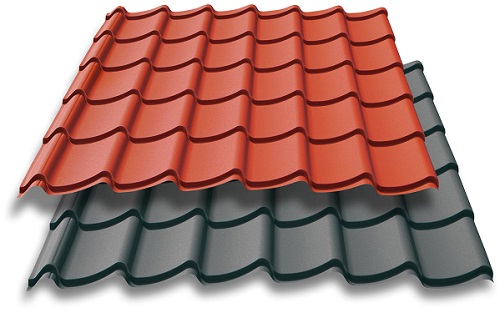
Sheets of metal meet all of the above requirements to the fullest. Profiled sheets with a corrugated corrugated shape imitate the surface of ceramic tiles, inheriting its basic technical properties and characteristics. The metal tile is made of hot-dip galvanized sheet with a thickness of 0.5-0.7 mm with a polymer coating according to GOST R 52146 and TU 14-1-4792. The choice of such a basis allows to achieve a high level of strength and reliability of the material.
The production technology provides for profiling by rolling, which allows us to guarantee the correct form of all finished products, without exception.
The composition of the sheet of metal includes special layers of substances and chemical elements that provide a high level of corrosion protection. In addition, the use of modern polymers allows you to perform a decorative function.
A metal roof is used to equip pitched roofs (slope greater than 12 °).
The main advantage of this material is its own weight. Despite the insulation and waterproofing, the weight of the roof compared to the use of other roofing materials will remain the lightest.
Basic rules for selecting elements for roof installation
For the installation of the roof, the main material is used - metal sheets, as well as accessories. A mandatory element of technologically correct installation is the use of anti-condensation films and thermal insulation material.
The main criteria for selecting a metal tile is the height of the corrugation, the size of which, according to the standard, is in the range of 10 - 25 mm.
The height of the corrugation, as well as the type and color of the polymer coating on the front side of the surface of the building material, is selected based on aesthetic tastes and requirements for architectural design.

When choosing, special attention should be paid to the thickness of the sheet. In order to prevent deformation during operation, a material with a thickness of at least 0.5 mm is used when installing a roof from a metal tile.
Among the modern heat-insulating materials provided for the implementation of such tasks, the most commonly used is slab, consisting of fibrous and foam materials, on a cement binder. In addition, backfill heat-insulating materials - shungizit, expanded clay, vermiculite, perlite can be additionally used.
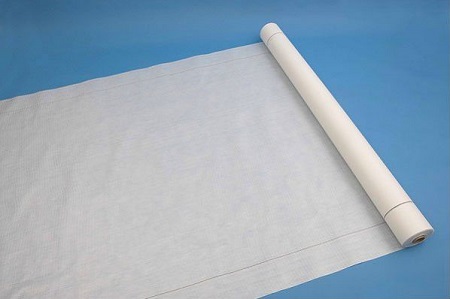
Anti-condensation films are usually made of vapor-proof, moisture-absorbing material.
To protect the attic from moisture that can penetrate from outside the building, the anti-condensation film is made from a moisture-absorbing non-woven material. The film is laid under the roof and its main purpose is to prevent condensate from dripping off for thermal insulation. The mechanism of action is based on the properties of a moisture-absorbing quick-drying material.
To protect the thermal insulation of buildings with high humidity from condensation, antioxidant films of vapor-proof material are chosen.

The installation of under-roof anti-condensation films is mandatory. Technical conditions for material selection are specified based on local conditions at the stage of project adjustment.
In places of joints (combining) of sheets, places of passage, as well as the exit of the chimney, roof sections are used on the formed sections of the coating material. Additional elements are intended to hide the raw edges of the metal, the formed cracks and gaps. When using roofing components, the technical characteristics of the integrity of the coating (reliability and durability) are supported, and the aesthetics of the appearance (attractiveness and neatness) are significantly improved.
The metal roof device offers a set of the following additional accessories:
- planks ridge, cornice, end, for seams, outer and inner corners, joints, etc .;
- snow retention;
- endow;
- passage elements;
- sheet to cover the outer recesses;
- outlet pipe.
In order to fix the sheets of metal, the following types of strips and parts are used:
- ridge plank on the Monterrey profile;
- the end on the ridge plank (for a tent roof, the end on the ridge plank and the U-shaped bar for the end of the tent roof);
- end plate 50? 50 mm (103? 115 mm);
- cornice strip for metal;
- level for internal seams and joints;
- for outside corners;
- for internal corners;
- with internal and external corners;
- for seams and joints;
- upper bar;
- lateral;
- bar for grooves.

Accessories for metal roofing are used in full, without fail. Refusal of accessories and additional elements can lead to improper installation of the roof, and therefore, to reduce the terms of its operation.
Installation technology and stages of work
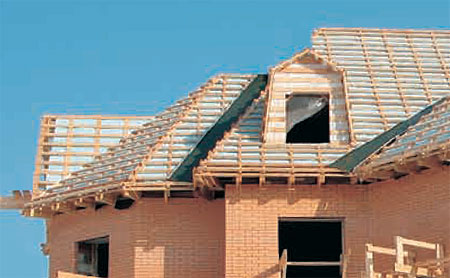
The installation of the roof is a complex and time-consuming process, which is quite difficult to carry out without expert advice and the help of an experienced partner.
Installation work begins from measuring slopes. In this case, the perpendicularity of the ends of the roof is established with respect to the lines of the eaves and the ridge.
The crate is made of boards with a section of 32x100 mm. The distance between the edges of the crate should be equal to 350 mm (equal dimensions between the edges of the metal tile). The distance from the outer edge of the cornice board is about 300 mm.

If the size of the transverse ribs of the metal tile differs from the standard, then the crate is arranged according to the new dimensions.
The technology of a roof made of metal involves the following conditions:
- The boards of the ribbed sheathing, as well as the wooden material at the end sections (extreme on the eaves) are located above the other boards.
- The edges of the sheets of metal are covered with a continuous sheathing boards.
- Installation of sheets begins from the end sections.
- All laps are performed at the transverse border of the sheet, observing a length of approximately 250 mm.
- The skate is closed with special additional accessories - ridge elements with a seal. The semi-cylindrical shape contributes to a more dense laying on the upper ends of the profile sheets of metal.
- On the cold inner surface of the metal tile create conditions for ventilation under the roof. To prevent the formation of condensate from the cornice to the ridge, roll material is placed under the crate.
- The roof endova is performed using a special jutting element. For this, an intermediate structure is mounted on the casing, on which a gutter element is attached.
- The gaps under the ridge, between the sheets and the gutter element, are sealed using special sealing tapes, or silicone or any other curable sealant.
- Fastening sheets is carried out by bolts or screws in accordance with the schemes.

When carrying out any installation work, you should walk in shoes with soft soles. It is important to try to step only in the deflection of the wave and in the places of the crate.
The roof device made of metal must be carried out in strict accordance with all stages of the work.
To prepare the roof for installation, it is necessary to evaluate the integrity and evenness of the surface. In cases where defects and irregularities are identified, measures are first taken to eliminate them. Also check the correctness of the roof size and shape, for this, measure the diagonals of the slopes. If it is technically impossible to correct the skew, then the tile is laid, aligning the lower edge of the crate with the line of overhang of the building material.

Roofing material is laid from the bottom up, while the top sheet should overlap the bottom. Installation of the roof starts from the lower left corner. And in order to ensure that the cornice line is even, during installation work, special attention is paid to laying the first sheet.
Installation of additional elements
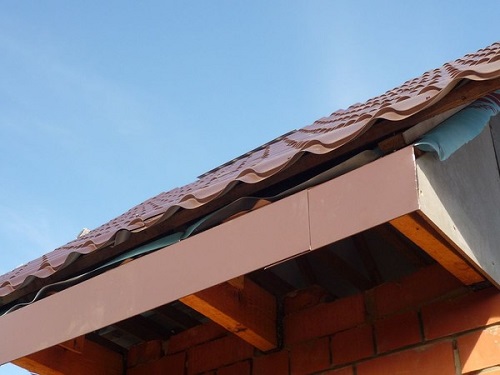
The technology of strengthening additional accessories and roof elements with a device made of metal has its own characteristics that must be taken into account.
The cornice strip for metal is attached to the last plank of the crate, while the overlap length of the planks is 100 mm. This fastening is done before mounting the base material.
End slats are attached on the gables from the bottom up. A feature of this type of installation work is that the strips should cover the end edges of the sheets.

Skate plates should be installed after installation of the roof, end plates, fixing the seal.
Roofing pie - structure and features of the device
As you know, the roof - a structure consisting of a different number of layers that perform various types of tasks. This set is called a roofing cake. A roofing pie for a metal tile, in most cases, consists of the following set of layers and elements:
- metal tile;
- lathing (unedged board 25x100mm or bar 40x50);
- counter-lathing (unedged board 25x100mm);
- waterproofing (diffusion membrane);
- vapor barrier;
- insulation (basalt plate 150mm);
- rafters (wooden beam 50x100 or 100x150);
- connecting tape (double-sided tape);
- the spillway is round;
- hook for attaching the gutter;
- windshield (wooden 30x150 edged);
- wind bar;
- horse;
- ventilation “hobbyhorse” in waterproofing;
- ventilation holes in the profile seal;
- ventilation gap between waterproofing.

The option of a roofing cake is determined depending on the type of roof individually and is fixed in the design documentation.
Roofing pie for various types of roofs
For a cold roof, a roofing pie for a metal tile consists of load-bearing structures, a metal tile, a counter-battens and a gyro-insulating film. Installation of such a film has some features.It is fastened with staples of a stapler (building) and pressed with self-tapping screws to the fastening boards of the counter-lattice.

When attaching the film to it, it is necessary to set some sagging (15 - 25 mm). This condition will help during operation to ensure ventilation of the lower side of the sheet of metal.
If this condition is violated, then moisture will accumulate in places of tight fit of the film, as a result of which the corrosion process will begin quite quickly.
Such a cold version of a metal roof in the construction of residential buildings is used quite rarely, this is due to the increased echo (sound conductivity) of the material.
In addition, this option of a cold roof has a number of the following disadvantages:
- low air permeability due to obstacles created by the crate;
- difficulty with fixing the waterproofing film on the rafters;
- the impossibility of installing a “ventilation ridge” in the waterproofing layer;
- increased consumption of wood for the crate.

In order to reduce the noise level, as well as to be able to more efficiently use the under-roof space, they arrange a warm roof. Although the cost of construction will be increased, the result of efforts and investment will be additional space for household and utility rooms.
The roofing pie under the metal tile will include the following layers:
- load-bearing roof structure (longitudinal girders, rafters);
- vapor barrier (provides one-sided moisture permeability);
- thermal insulation;
- ventilation gap (the space between the insulation and rafters and girders;
- waterproofing (waterproof film, or membrane with one-sided permeability to the outside);
- counter-lattice (serves for fastening the lathing and pressing the waterproofing);
- lathing (a beam of a certain design section, on which the roof is attached);
- sheets of metal.
The roofing pie under the metal tile has a weak point - insulation. It is quite important before weighing insulation to weigh all the features of the material, or consult with a specialist. For example, when choosing a foam as a foam, it is necessary to take into account its higher cost in comparison with rolled thermal insulation (mineral or glass wool). In addition, this material does not have sufficient flexibility, which leads to the formation of additional waste with a non-standard pitch rafters.
The most popular type of thermal insulation materials are technical wool. However, the hygroscopicity is considered a feature of this variant of the material. Such a disadvantage is found in the collection of moisture. With high humidity, the unprotected layer loses up to 80% of its insulating properties.
In order to prevent violation of the thermal insulation of the roofing pie, the metal roof structure includes gaps between the thermal insulation (from 30 to 40 mm) and the upper layers of the roof, as well as between the waterproofing and the metal tile (from 10 to 15 mm).

To remove moisture in the insulation, a natural blowing method is used.
How to install
Installation work on the installation of layers of roofing made of metal is carried out in a specific order, the violation of which will lead to a weakening of performance.
- Installation of a vapor barrier. The vapor barrier film is attached on the inside of the rafters. In some cases, it is necessary to fasten the film with a gap (provided by counterrails with a thickness of 30 mm or more).
- Installation is carried out in the direction from the bottom row to the top, while the overlap is 100 mm.
- Formed and longitudinal joints are sealed with a vapor barrier.
- Insulation (gaps) is carefully stuffed into the space between the lags.
- Waterproofing is installed using a similar technology.

The roofing pie should be fully arranged before the installation of the metal tile sheets immediately begins.
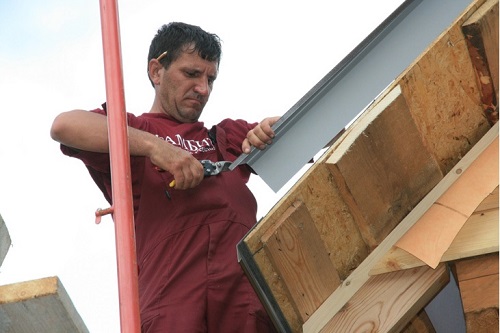
When installing the roof, it is important to take into account the peculiarities of fastening not only sheets, but also individual additional nodes and elements. Such attention to detail will ensure the reliability of the entire structure and eliminate the risk of the formation of "weak" spots not only on the surface, but also on the entire roof.
When installing the end strips, it is necessary to observe the rule of fastening them to each other (overlap of 2 cm or flanging)
If the tile is not adapted to the width of the ramp according to the wave size, it may turn out that the lower crest of the wave will fall on the pediment. In this case, it is recommended to add an additional roofing strip or adjust the pediment overhang.

To improve the fit of materials, it is recommended to lay an additional layer of sealant with a sheet of metal tile and a bar.
In cases where the elements of the roof made of metal are installed independently, typical errors occur. For example, quite often in a rectangular slope, when attic windows are installed, metal tiles are embedded in an incision. "Apron" of the window. With this approach, a hole is formed in the roof along the edge of the notch.
When arranging dormer, dormer-windows, pipes located below the ridge, it is necessary to strictly adhere to the technology of using metal tiles when covering the roof. In this case, the use of single-module sheets is recommended (two sheets for each element).
Rules for installing the skate strap
Setting the level of the ridge also requires compliance with some rules:
- Before mounting the plank of the ridge, it is recommended that work be done on the under-roof ventilation device.

When carrying out installation work on the roof with gentle slopes, it is necessary to install an aero roller between the ridge strip and the sheets of metal tile. Such a structural approach will reduce the risk of snow falling under the ridge.
- When installing point ventilation openings in the ridge, it is mandatory to install a sealant.

When carrying out this type of installation work, the skate is mounted on the end plates, and the work is carried out from the end. The protrusion of the edge is 20-30 mm.
- When installing a flat ridge, the parts are lapped. The semicircular ridge is fixed along the profile lines.
- If the roof has an angle of inclination of more than 45 degrees (sharp), you must accurately calculate in advance the combination of the model of the ridge and the angle of inclination of the roof. Such calculations are recommended to be entrusted to specialists, because a small error in the numbers may lead to the need to purchase metal tiles in full.
- In order to more accurately repeat the angles of inclination of the roof slopes, it is recommended that the skate shelves be bent or unbent as necessary.
- The ridge nodes of the roof made of metal for trapezoidal and triangular slopes are mounted according to the scheme of fitting the plank to the corner of the ridge. In this case, it is recommended to cut the straight skate in accordance with the corners. Installation of a semicircular ridge involves the installation of a plastic plug.
- The ridge nodes of the roof made of metal for trapezoidal and triangular slopes are mounted according to the scheme of fitting the plank to the corner of the ridge.

It is recommended that you replace the plastic plug that comes with the kit with a steel one made by craftsmen yourself.
It should be ensured that the axis of the ridge of the ridge corresponds to the axis of the ridge. If the angles of adjoining slopes are the same size - this is easy. In another embodiment, specialists use a bright mounting tape or a plastic V-tee to monitor the relevant abutments.
Endova Installation

A special place in the construction of a roof made of metal are the places of the device of the valley. On the roof, this place starts from the ridge and goes down to the ledge.
The technology of the device involves the installation of an additional board for each endow. It is important to remember that the strips must be installed from the bottom up. The overlap with this technique is 20-30 cm.
When carrying out installation work, it is recommended that the lower valley of the valley be cut below the cornice line. Flanging is done along the cutting line. As well as under the ridge under the flange, it is necessary to install a universal seal.

The gap between the axial line of the valley and the sheets of metal should be at least 6.0-10.0 cm.
Checking the correct assembly of the construction of the roof from metal is quite simple. With the correct performance of all work with strict observance of all requirements at the attachment points, the coating sheet should touch the board. In case of miscalculation or error, the metal tile will be fixed at other points, which will lead to the formation of gaps. Such a defect will certainly lead to leaks in the first period of operation.
In order to close the cut sheets, the valleys are decorated with decorative overlays. When implementing this process, experts recommend:
- mount a decorative overlay from bottom to top;
- compliance with the size of the overlap (at least 10 cm);
- between the decorative overlay and the metal tile installation of a sealant is not provided;
- the installation of the decorative cover provides for the accurate installation of self-tapping screws (absence of damage to the endova strip).
The device of a roof made of metal provides for various types of structures. Some of them provide for the presence of a valley, which begins and ends on slopes. If we consider the case of the correct installation of the dormer, then it is not difficult to notice the additional installation of the board under the valley. The technology of such an installation assumes a level of cutting of a sheet of metal tile 20 cm higher than the exit of the valley on the slope. Cutouts are made under the front and side walls of the dormer window in the cover building material. Installation work involves the following work processes:
- installation along the walls of the dormer window seal;
- closing with a strip of eaves overhang;
- installation of an endova level;
- Trimming the slope and the ledge.
In order for the edge facing the slope to fit snugly against the sheet of metal tile, it is recommended that the upper edge of the valley be formed manually. It is also necessary to line the bottom sheet with a mallet. If necessary, you can extend the endow, but provided that the overlap size is 20-30 cm. In most cases, the adjoining of the endows is fixed with self-tapping screws and sealant.

Under the flanges of the valley, it is necessary to install a sealant. On the main slope above the valley sheets are laid according to a scheme that provides for fixation between the upper and lower row. It is more than 20 cm.
Pipe bypass
The technology of the roof device involves installation work not only on a flat surface. The roof design involves the installation of pipes and other objects.
When installing coating material, it is necessary to take into account all the features of the correct installation work. For professional bypass of the pipe, it is necessary to pre-prepare its surface at the junction.
At the preparatory stage, the following types of work:
- the surface of the pipe is completely plastered;
- waterproofing on the sides;
- on a slope at a distance not further than 80 cm from the rear wall, a drainage groove is installed;
- an additional crate is installed above the pipe.
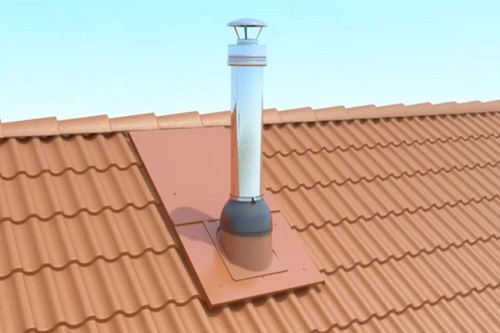
When installing the roof, the sheets of metal that are located on both sides of the pipe are cut off over the stamping line. In this case, the cut will pass at a distance of not more than 15 cm from the pipe to the stamping lines.

The upper and lower aprons are measured on the side, the height of which is at least 15 cm. The measurement is carried out from the top of the roofing.
In order for the design to meet all the requirements of reliability and integrity, it is also necessary to carefully measure the side of the apron that lies on the ramp (height not less than 20 cm). A prerequisite is the apron closing the nearest crest of the wave. Aprons are fastened with self-tapping screws with sealant. The use of a sealant is mandatory.
Following the sequence of actions, you must first connect the lower and side aprons, and then proceed with the installation of the upper. A prerequisite for installing the upper apron is the covering of sheets of metal on 10-20 cm.

The upper apron must not be mounted in an incision in a metal tile. With such a defect in the installation work, leakage of water under the roof is inevitable.
If the pipe is located at a distance of less than 1 m from the ridge, then the installation of a metal roof is much easier to carry out. In this case, the upper part of the apron is brought under the ridge.
The danger of the location of the pipe on the ridge is considered an unprofessional approach when sealing the joints of the side aprons of different slopes.
If on the roof there are objects with a width of more than 0.8 m, the installation of metal is carried out in accordance with the rules, requirements and instructions used when installing the valley. In this case, the nodes of the roof made of metal tiles form a ramp formed by two additional slopes. According to the technology, the slopes are covered with metal tiles and arrange valleys.
The option, in which the width of the object does not exceed 1.2 m, provides for covering the ramp with a flat steel sheet instead of the main coating material.
However, there are more complex structural solutions. In the case when the shape of the pipe is round, then you can’t do without the help of specialists. Bypassing a round pipe when installing a roof made of metal is a very complex technical process. Turning to specialists for help, it should be remembered that the prices for installation work on this section of the roof are much more expensive than on the rest of the surface.

The device of a round pipe will complicate the process of mounting the roof of a metal tile.
The advantages of using metal
Choosing a metal tile as the main coating material for your roof, you must consider that this is a modern covering material with a huge list of advantages.
Technical characteristics, as well as high operational properties, make it possible to maintain a high level of consumer demand in the market of domestic coating materials. Today it is possible to choose the necessary covering material for any type of pitched roofs, corresponding to various requirements. Construction stores are ready to offer customers products of various brands and manufacturers.
To make a final decision when choosing this material, it is necessary to consider its advantages and disadvantages in more detail.
Advantages of a metal roof:
- in comparison with other covering materials (ceramic tiles and slate);
- simplicity and ease of installation work on the roof device (the ability to install with certain skills);
- wide range of color palette (over 40 tones);
- the presence of stiffeners, which ensures high strength of the material;
- high technical properties and operational characteristics;
- compliance with modern requirements;
- environmental friendliness.
One of the drawbacks we have examined is noise during hail and rain. In addition, with independent cutting of the roof, a large amount of waste of profiled material remains.
With a competent analysis of the main advantages and disadvantages of this material, the conclusion becomes obvious even to a specialist. The coating of metal is quite durable and beautiful.
Subject to all the considered structural features of such a roof and the moments of installation work, the roof of a metal tile is guaranteed to stand idle for about 50 years.
However, it should be remembered that flat roofs with profiled metal sheet do not lie. The slope of the roof under the coating of metal is from 1.5-2 to 11 degrees.
We hope that the tips and recommendations discussed will help determine the design of your roof, its main nodal elements, features and equipment.

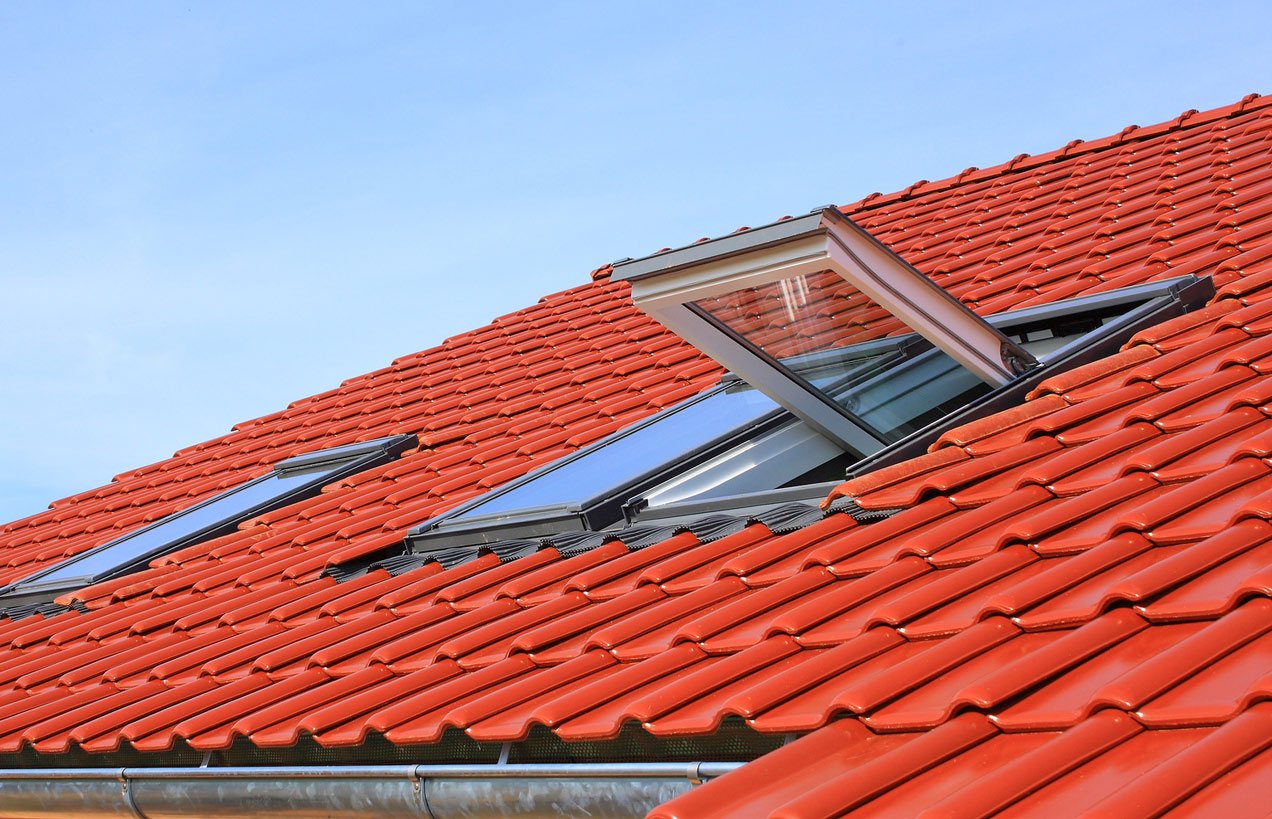



Alas, no comments yet. Be the first!